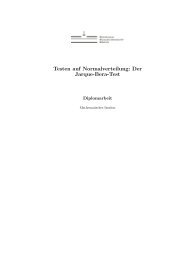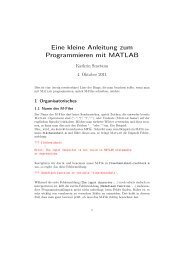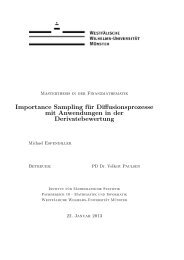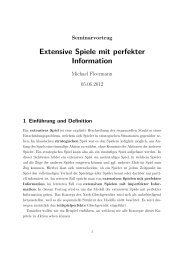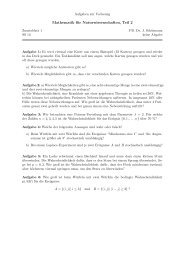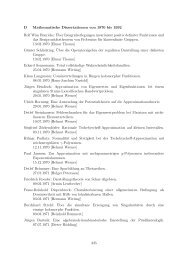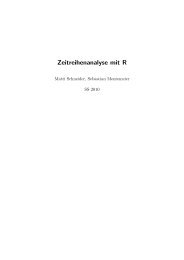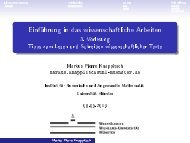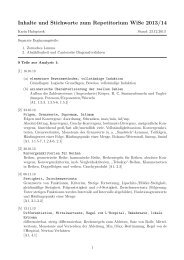Margulis Lemma
Margulis Lemma
Margulis Lemma
Create successful ePaper yourself
Turn your PDF publications into a flip-book with our unique Google optimized e-Paper software.
44 VITALI KAPOVITCH AND BURKHARD WILKING<br />
finite index. This in turn implies that π 1 (M i )/N i is virtually cyclic and by a) we<br />
can assume that it is a fixed group F.<br />
The result (contradiction) will now follow algebraically from b): Let ρ j : F →<br />
GL(n j , Q) be a finite collection of irreducible rational representations j = 1, . . . , j 0 .<br />
Consider, for all nilpotent torsion free groups N of rank n − 1, all short exact<br />
sequences<br />
N → Γ → F<br />
with the property that there is a chain {e} = N 0 ⊳ · · · ⊳ N h0 = N such that<br />
[N, N h ] ⊂ N h−1 , each N h is normal in Γ, N h /N h−1 is free abelian group of positive<br />
rank and the induced representation of F in (N h /N h−1 )⊗ Z Q is in the finite collection.<br />
Using that F is virtually cyclic, it is now easy to see that this leaves only finitely<br />
many possibilities for the isomorphism type of Γ/N h0−1. This shows that if we<br />
replace N by N h0−1 we are still left with finitely many possibilities in a). – a<br />
contradiction.<br />
□<br />
Corollary 9.4. Given n, D there is a constant C such that any finite fundamental<br />
group of an n-manifold (M, g) with Ric > −(n − 1), diam(M) ≤ D contains a<br />
nilpotent subgroup of index ≤ C which has a nilpotent basis of length ≤ (n − 1).<br />
Example 2. Our theorems rule out some rather innocuous families of groups as<br />
fundamental groups of manifolds with lower Ricci curvature bounds.<br />
a) Consider a homomorphism h: Z → GL(2, Z) whose image does not contain<br />
a unipotent subgroup of finite index. Put h d (x) = h(dx) and consider the<br />
group Z ⋉ hd Z 2 . By part b) of Theorem 9.3 the following holds:<br />
In a given dimension n and for a fixed diameter bound D only finitely<br />
many of these groups can be realized as fundamental groups of manifold<br />
with Ric > −(n − 1) and diam(M) ≤ D.<br />
b) Consider the action of Z p k−1 on Z p k induced by 1 ↦→ 1 + p. In a given<br />
dimension n we have that for k ≥ n and p > C Marg (constant in the<br />
<strong>Margulis</strong> <strong>Lemma</strong>) the group Z p k−1 ⋉Z p k can not be a subgroup of a compact<br />
manifold with almost nonnegative Ricci curvature, since it does not have a<br />
nilpotent basis of length ≤ n.<br />
Similarly, by Corollary 9.4, for a given D there are only finitely many<br />
primes p such that Z p n−1 ⋉ Z p n is isomorphic to the fundamental group of<br />
an n-manifold with Ric > −(n − 1) and diam(M) ≤ D.<br />
Problem. Let D > 0. Can one find a finite collection of 3-manifolds such that for<br />
any 3-manifold M with Ric > −1 and diam(M) ≤ D, there is a manifold T in the<br />
finite collection and a finite normal covering T → M for which the covering group<br />
contains a cyclic subgroup of index ≤ 2?<br />
10. The Diameter Ratio Theorem<br />
The aim of this section is to prove Theorem 8.<br />
<strong>Lemma</strong> 10.1. Let X i be a sequence of compact inner metric spaces converging to<br />
a torus T. Then π 1 (X i ) is infinite for large i.<br />
The proof of the lemma is an easy exercise.



